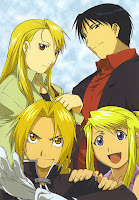I just finished watching K and all I can say is: “How could they ruin a great series that
way!!??!!” Needless to say I was less
than happy with the ending. And once
again had it confirmed that you can’t decide whether a series is any good until
you see the ending. Damn!
K has everything going for it – awesome, way cool
characters, great music, a really unique plot.
It’s too short of course. Only 13
episodes. But besides that, it’s a
wonderful series, right up until they kill main characters in the last
episode. Damn, I really hate when they
do that.
So what’s it about?
It’s about color Kings. A genius
researcher named Adolf Weissmann discovers how to essentially give people super
powers. Each King has a different super
power associated with a different color.
Weissmann himself is the first and original King, the Silver King, and he can manipulate gravity and
is immortal. Central to the story are the Red King, Souh Mikoto, and the Blue
King, Munakata Reishi. The Kings,
because of their powers, cause people around them who have the capacity to gain
lesser powers like theirs. So each
King has a group of followers. Mikoto’s
follows are a yakuza-like gang called HOMRA.
Reishi’s followers are a paramilitary group called SCEPTOR 4.
The story line revolves around three characters, 1) an apparently clueless,
white-haired kid named Isana Yashiro, or Shirou for short, 2) a cat/girl named Neko who appears in girl form in the first two pictures in this blog and in cat form in the last picture, and 3) a cool, powerful fighter named Yatogami Kurou, nicknamed the Black Dog. At the beginning of the story a much beloved member
of the HOMRA is murdered by the new Colorless King – a wildcard King with the
ability to effect, and in this case take over, the other Kings. Shirou is pegged as the murderer and spends
much of the series fleeing various groups while occasionally showing seriously
powerful abilities himself.
A lot of confusion and twists ensue, but bottom line is that
Shirou is actually Weissmann. Weissmann has been
switched into Shirou’s body by the colorless King, and eventually he remembers
this and realizes the colorless King is inhabiting a friend of theirs, Kukuri. The colorless King is also inciting the Red
and Blue Kings to fight until they’re both weak enough for the colorless King
to take them over. Kurou and Neko swear allegiance to Shirou/Weissmann. In order to save Kukuri, Weismann reabsorbs
the colorless King and traps him inside, then allows the Red King to kill them
both, since only a King can kill a King. The Blue King then kills the Red
King to keep him from self destructing and destroying everything for miles around him. End of story.
 See? Horrible
ending. Dead Kings! Souh Mikoto, the red King, is
definitely dead, as is the wacko colorless King. Shirou may be but Kurou and Neko remember that Shirou/Weissmann/the Silver King has said he’s immortal, so they go looking for him. It’s likely that he survived, although they
do not show him alive in the series. Still,
I really liked Souh Mikoto and hate that they killed him off.
See? Horrible
ending. Dead Kings! Souh Mikoto, the red King, is
definitely dead, as is the wacko colorless King. Shirou may be but Kurou and Neko remember that Shirou/Weissmann/the Silver King has said he’s immortal, so they go looking for him. It’s likely that he survived, although they
do not show him alive in the series. Still,
I really liked Souh Mikoto and hate that they killed him off.
I also wish the series had been longer. It’s a really cool series and there’s a lot
that could have been done with it. It's definitely worth watching. Just brace
yourself for the ending.


















































